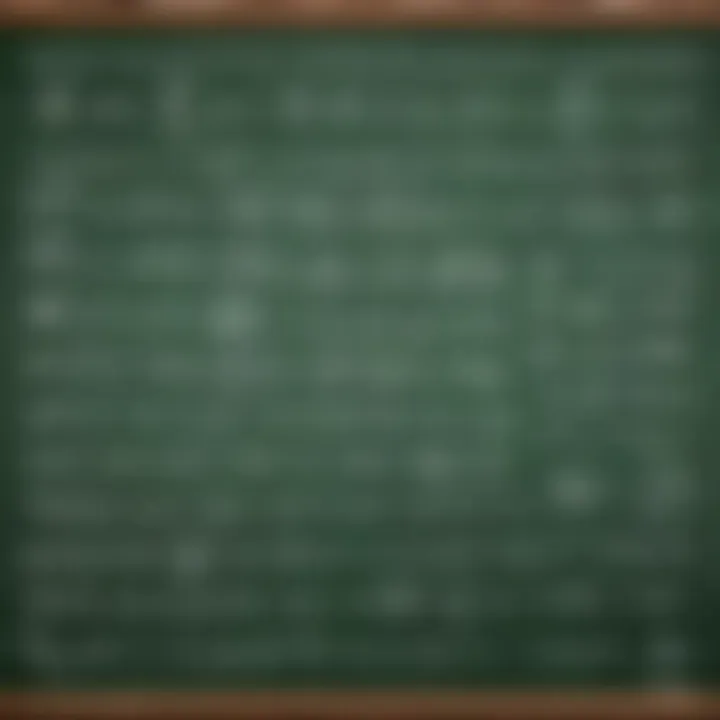Mastering Equation Solving: A Comprehensive Guide


Intro
Understanding equations can be a challenge for many students. However, it is a vital skill. This guide is for those seeking clarity in equation solving, including both parents and caregivers. Here, we unpack the essentials of different types of equations and effective strategies to solve them. We aim to transform equation solving from a complex concept into an easily approachable subject. This will benefit students significantly, helping them build confidence in their mathematical skills.
Creative Activities
Engaging with equations does not have to be limited to pencil and paper. Artistic activities can significantly enhance learning. Here are some suggestions.
Craft Ideas
- Equation Cards: Create cards with different equations for kids to solve. They can color the cards to make them more appealing, turning learning into a creative task.
- Equation Posters: Have kids design posters displaying important equations and the methods to solve them. This visual element can be a constant reminder.
Step-by-Step Guides
- Gather materials: Collect paper, colors, and markers.
- Choose an equation type: Decide on simple equations that you want to illustrate.
- Design: Allow the children to express themselves through colors and drawings while integrating equations scientifically.
- Present: Once the projects are complete, allow them to present to family or peers.
Following this methodology not only brings a sense of ownership to students but also solidifies their learning.
Educational Value
These activities nurture creativity while reinforcing mathematical concepts. Engaging students through different formats helps cater to various learning styles. As they work on these crafts, students practice problem-solving, improve their reasoning, and enhance their comprehension of equations in a relaxed setting.
Fun Quizzes
Quizzes serve as an interactive tool to assess understanding and promote valuable reflection on equation solving.
Quiz Topics
A range of topics can be addressed, including:
- Basic addition and subtraction equations
- Multiplication and division complexities
- Solving for unknowns in a straightforward equation
Question Types
Diverse question types can keep children engaged, such as:
- Multiple choice questions that encourage selection of correct methods to solve equations.
- True or false statements to assess immediate understanding and logical reasoning.
- Fill-in-the-blank questions for basic operations in equations.
Knowledge Reinforcement
Through quizzes, children can witness their progress. This reinforcement helps in solidifying their understanding. Ensuring students do quizzes regularly can help track growth, allowing them to develop a stronger foundation in equations.
Fact-Based Articles
Reading materials can further nurture understanding in a structured and cohesive way.
Topics
Fact-based articles can explore:
- The evolution of mathematical equations.
- Real-life applications for solving equations in daily scenarios.
- Profiles of mathematicians who advanced the field.
Engaging Content
These articles should be presented in a simplified manner to facilitate reading for elementary level students. Using straightforward charts or diagrams can break down more complex topics into manageable sections.
Understanding Equations
Understanding equations is fundamental to grasping the concepts present in mathematics. Equations serve as a bridge between various mathematical ideas and real-life applications. The relevance of mastering equations is not simply academic; it contributes sharply to problem-solving skills that are useful both in education and everyday life.
Equations symbolize a relation that demands a balance. Understanding them enhances one's analytical abilities and numerical literacy, which are vital in today’s data-driven world.
This section discusses several essential notions regarding equations. Completing your comprehension opens new perspectives for mathematics learning and provides users a toolkit to tackle diverse problems.
What is an Equation?
An equation is a formal statement indicating the equality of two expressions. In its essence, it contains two sides, often separated by an equal sign (=). The value of an equation becomes clear once you understand the relationship it sets. For example, in the equation 2x + 3 = 7, the equation claims that when 2x is increased by 3, the result equals 7.
The simplicity of this definition belies the deep implications of equations. They can express anything from straightforward arithmetic to complex relationships in physics, finance, and engineering. Recognizing this can deepen one’s appreciation of mathematics as a logical language.
Components of an Equation
Understanding the components of an equation helps clarify how to approach problem-solving. Several essential elements come into play:
- Variables: Usually denoted by letters, variables stand for unknown values that must be solved.
- Constants: These are fixed numbers that stay the same within the equation, such as 3 or 7 in our example above.
- Operators: These mathematical symbols (like +, -, *, /) illustrate the operations needed to relate the variables and constants.
- Equality sign: This crucial component denotes that the expression on the left is equivalent to that on the right.
Having a strong grasp of these parts facilitates understanding and manipulation of equations, thus playing an integral role in solving mathematical problems.
Types of Equations
Several types of equations exist, each with unique attributes:
Linear Equations


Linear equations consist of variables raised only to the first power. Their structure is basic, typically resembling the form ax + b = c, where a, b, and c are constants. The beauty of linear equations lies in their simplicity. They demonstrate direct relationships between variables, making them ideal for beginners. Graphically, they are represented as straight lines on a Cartesian plane. This straightforwardness allows for an easy understanding of slopes and intercepts.
However, while they are easier to solve than other types, linear equations might not embody the complexity found in real-world scenarios. Thus', their applicability might seem limited without further exploration into more intricate equation forms.
Quadratic Equations
Quadratic equations are more complex, featuring variables squared. The standard form is usually represented as ax^2 + bx + c = 0. They provide a broader range of solutions compared to linear equations. Quadratics can have two real roots, one real root, or even no real roots at all, portraying more complicated relationships.
These equations are pivotal when modeling scenarios that involve quadratic phenomena, such as projectile motion. Recognizing them expands an individual's analytical encode and lays the groundwork for advanced mathematics that students will encounter later in their education.
Exponential Equations
Exponential equations contain variables in their exponent positions, typically taking the form a^x = b. They are key in certain fields of study, including biology and economics, and help understand growth phenomena such as populations or finances. Their unique characteristic is that they can yield substantial changes with relatively small adjustments in input.
However, expert behaviors such as verifying results using logarithms may lead some students initially to avoid engaging deeply with these types of equations until they become more fundamental.
More Complex Equations
More complex equations encompass those including multiple variables and operations/methods. They might involve systems of equations or polynomial equations. Evaluating these requires sophisticated knowledge of mathematics. In varied real-life scenarios, for example, determining equilibrium in chemical reactions often utilizes complex equations.
They allow for multi-faceted analyses and provide richer insights. Yet, the problems may overwhelm beginners if lacking strong foundations in simpler equation types.
Understanding the categories and unique features of each equation type enhances overall numeracy and encourages the application of mathematical principles in quantifiable matters in life.
The Basics of Solving Equations
Understanding the basics of solving equations is fundamental for anyone learning mathematics. This section provides clear methods and techniques that simplify the learning process, laying foundations for more complex problem-solving. Gaining a grasp of these basics aids in developing critical thinking and logical reasoning, skills essential not just in math, but across various subjects.
You can think of solving equations as a way to uncover the unknown, enabling you to find values behind letters and symbols. It promotes a structured way of thinking and applying rules consistently across problems.
Understanding the Equation Balance
Every equation is balanced, meaning what is done to one side must also be do on the other. This balance is essential. It ensures that the equation holds true. For example, in the equation 2x + 3 = 7, isolate the variable step by step, maintaining the balance through operations:
- Start with the given: 2x + 3 = 7
- Subtract 3 from both sides: 2x = 4
- Finally, divide by 2: x = 2
Understanding this balance reassures students that every operation is permissible so long as it is uniform. Practicing this approach helps deepen their comprehension and provide a structured methodology when approaching equations.
Using Inverse Operations
Inverse operations are at the crux of solving equations. The concept hinges on performing the opposite operation to remove a variable or constant from an equation.
For instance, if you have 3x = 12, dividing by three (the inverse of multiplication) helps to isolate the variable x:
- Step 1: Start with the equation 3x = 12
- Step 2: Use the inverse process, dividing both sides by 3 to result in x = 4
By mastering inverse operations, students not only streamline their problem-solving process but also attain a critical understanding of mathematical relationships. Practicing these steps builds a sizable confidence in handling variables and equations across various disciplines.
Practicing the basics will make even the most complicated equations more manageable, and equip learners with techniques needed for success in mathematics.
In summary, these basics set the groundwork for tackling a wide assortment of equations. They offer valuable insights and methods that encourage informed approaches to problem-solving, gearing students for more challenging mathematical explorations.
Solving Linear Equations
Linear equations represent foundational mathematical concepts. They arise in many scenarios, making their mastery vital. Understanding how to solve linear equations equips students with analytical skills applicable in various disciplines, not just mathematics. This section delves into the fundamental practices required to effectively solve these equations.
Step-by-Step Approach
Solving linear equations can seem intimidating, but a clear method can simplify the process. Here are common steps involved:
- Identify the Equation: First, ensure the equation reads as a straight-line equation. This usually includes forms likeAx + B = C, where A, B, and C are constants.
- Isolate the Variable: The goal is to get the variable (usually denoted as x) by itself on one side of the equation. To achieve this, you can perform operations on both sides to maintain the balance.
- Apply Inverse Operations: If you have x plus a number, subtract that number from both sides. If it's multiplied, divide accordingly. This step is crucial for achieving the practical solution.
- Simplify: After isolating x, simplify the equation as much as possible. This means carrying out any addition, subtraction, multiplication, or division processes until you're left with x = some value.
- Check Your Solution: It is always wise to plug your solution back into the original equation to verify whether it holds true.
Following these steps ensures a structured approach, increasing the likelihood of arriving at the correct answer. It's also a powerful way to build confidence.
Common Mistakes to Avoid
Even simple processes have traps students might fall into. Here are some common mistakes to be aware of:
- Neglecting to Balance the Equation: When performing an operation, forgetting to do it on both sides can lead to incorrect conclusions.
- Mistaken Operations: Confusing addition with subtraction or multiplication with division often leads to significant errors. It's important to double-check operations.
- Moving Terms Incorrectly: Moving terms across the equation without reversing their signs is a classic mistake, such as thinking that if you move -5, it will remain -5 instead of becoming +5.
- Skipping Steps: Some students might rush and neglect showing all their work. This can lead to misunderstandings and mistakes that grow harder to spot without clear steps.
Keep these mistakes in mind as you practice. Awareness leads to mastery.
Important: Patience and practice are essential for improving your equation-solving skills. Take your time working through problems—accuracy boosts confidence!
Functions and Their Role in Equations
Understanding functions is crucial for grasping how equations operate. Functions can be viewed as mathematical machines. They take inputs and provide corresponding outputs. This relationship indicates how changing one variable affects another. By mastering functions, one can better understand the various types of equations they will encounter.
Understanding Functions
A function connects an input value in the domain to an output value in the range. The notation used for functions can vary, but a common way to express it is by using f(x), where x represents the input value. Functions have specific properties that help us analyze and solve equations.
Here are basic characteristics of functions:
- Each input must have exactly one output.
- The representation can be visual, numerical, or algebraic.


For students learning about functions, visualizing them using graphs can make concepts clearer. Graphs help highlight how certain values interact with each other.
It is important to understand the difference between functions and non-functions. For example, in a simple equation like y = 3x + 2, each x value has a single corresponding y value. However, for a relation like x² + y² = 1, the same y value can come from different x inputs, indicating the relation doesn’t define a function.
Functions in Real-world Applications
The relevance of functions translates directly to everyday situations. They model real-world phenomena. Knowing how to apply functions is key to problem-solving.
Here are ways functions find their place in real life:
- Finance: Calculating interest or profits based on changing investments.
- Physics: Understanding movement, where acceleration depends on velocity.
- Biology: Observing population growth that relies on various environmental factors.
Applying functions in those fields allows us to predict behavior and sight trends. Using software tools like graphing calculators can enhance this understanding further.
Learning how to implement functions can deeply enhance your end skills and can streamline many interaction processes both academically and in real life.
As we see, functions serve as foundational blocks in the construction of equations. Gradually building this understanding provides a substantial advantage as students advance their studies in mathematics.
Solving Quadratic Equations
Quadratic equations form a significant part of algebra and have various applications in real life. Understanding how to solve these equations not only reinforces algebraic principles but also sharpens analytical skills. This section unpacks methods and graphical representation involved in solving quadratic equations. It aims to provide readers with a grasp of techniques that are essential for effective problem solving.
Methods of Solving Quadratic Equations
To tackle quadratic equations, multiple methods can be applied. Each has unique features, advantages, and certain contexts where one might shine over others. Below, we explore three common approaches: Factoring, Completing the Square, and the Quadratic Formula.
Factoring
Factoring is a strategy for simplifying quadratic equations. By breaking down a quadratic expression into two binomials, the problem becomes manageable. A key characteristic of factoring is its relational approach. Misinterpretation can lead to errors, yet it remains a preferred method because it hones fundamental factor skills. Factoring simplifies the solution-finding procedure when possible, resulting in quicker evaluation.
The unique feature of factoring is its connection to the roots of the equation it solves. If the equation can factor into terms that equate to zero, from which the values of x can be derived. This method is generally beneficial as it often offers real number solutions when the discriminant (part of the quadratic formula) is greater than zero.
However, limitations exist. Not all quadratic equations factor neatly. Sometimes, you may not even realize the coefficients work against a clean factor pair, necessitating a switch to alternative techniques.
Completing the Square
Completing the square involves restructuring a quadratic equation into a perfect square form, which can lead to clear insights. A key aspect of this method is the capability to transform any quadratic equation into a solvable format. It illuminates concepts like vertex and axis of symmetry. Completing the square is preferred for its versatility in teaching concepts underlying quadratic functions. It allows direct visualization of these properties by hinging on basic algebra.
The unique feature of this method is that it reliably yields real solutions. It can also be a pathway towards identifying the vertex of the quadratic graph. An advantage of completing the square rests in its clarity; adjustments and visualizations follow a logical sequence. However, rewriting into perfect squares can complicate early steps in simple problems.
Quadratic Formula
The Quadratic Formula serves as a powerful tool within algebra for solving quadratic equations of all sorts. Expressly given, it can be noted as x = (-b ± √(b² - 4ac)) / (2a). A key characteristic is its universal application; it can solve any quadratic, which makes it a master key in math. The formula shines as a reliable final resort, especially when equations cannot easily solve through factoring or completing the square.
This formula’s unique feature is its ready extension, affording a direct glimpse into possible solutions. Whether the result yields two real solutions, one real solution, or none, understanding discriminants in context is invaluable. However, it may seem intimidating to some, pulling students into rapid calculations that can lead to minor missteps amid complex calculations.
Graphing Quadratic Functions
Graphing forms an important facet of examining quadratic functions. A quadratic function's graph—television as a parabola—provides visual representations of the equations solved. It illustrates roots, intersections, and the maximum or minimum values arising. Detailed comprehension of how to propagate quadratic functions visually marks a leap beyond basic algebra and empowers students towards deeper skills reservoirs. It also aids in validating other solving methods, enhancing the learned resilience toward mathematical presentations. Graphing reinforces the techniques mentioned, making their importance clear.
Choose the method that aligns with your comfort level and needs. Explore techniques and find solutions with each one!
Through practice, anyone can build. Use these methods wisely to tackle solutions effectively.
Importance of Practice in Mathematics
Mathematics, and in particular, equation solving, demands more than just understanding concepts. It requires consistent practice. The act of solving equations shapes cognitive skills like problem-solving, critical thinking, and analytical abilities. Through regular practice, students grasp the structure of equations and recognize patterns in problem-solving. This vital process builds confidence, allowing them to tackle various mathematical challenges with ease.
Why Practice Matters
Regular practice solidifies mathematical skills. When students engage in solving equations repeatedly, they encounter different problem types which enhance their adaptability. Practice introduces familiarity with question formats, thus enabling quicker recognition of solution strategies. Moreover, it provides instant feedback. If an error occurs, students learn to identify and rectify their mistakes. This iterative process greatly contributes to long-term retention of mathematical principles.
Additionally, consistent practice alleviates math anxiety. Many students view mathematics as daunting. However, as they solve more problems, starting with basic ones and advancing to complex equations, their apprehensions diminish. Feelings of competence replace uncertainty, ensuring that from elementary school through further education, they are less likely to shy away from demanding equations.
Resources for Practice
Finding the right resources can enhance your equation-solving practice.
- Workbooks and Exercise Books: Textbooks often contain valuable exercises for practice. Using resources like the Math Workbook for Dummies can supplement classroom learning effectively.
- Online Platforms: Websites such as Khan Academy and IXL offer interactive problems and tips for solving equations. Use these tools to practice anytime.
- Educational Apps: Apps like Photomath allow students to work through equations step-by-step, helping reinforce concepts while offering instant support.
- Study Groups: Engaging with peers can also boost understanding. Forming study groups encourages collaborative learning, allowing students to discuss and solve equations together.
- Tutoring: Having a tutor offer individualized guidance could be beneficial. It illuminates areas of difficulty and provides tailored assistance.
Understanding that practice is essential goes beyond memorization of formulas. It transforms numbers and symbols into an engaging quest for knowledge where each problem solved leads to new understandings
Remember, mathematics is not a spectator sport; the more you practice, the better you will become!
Exploring equation-solving practice resources can empower the student. As a precious asset, continuous practice fosters improved skillsets that powerful students can use throughout their educational journey.
Debugging Common Errors
Debugging common errors while solving equations is essential for developing a strong foundation in mathematics. One cannot overlook that every mistake offers a valuable lesson. Understanding these errors helps learners not just grasp mathematical concepts but also fosters critical thinking skills. This section addresses key aspects of identifying and rectifying pitfalls when solving equations—the result being better preparedness for various mathematical tasks and tests.
Identifying Mistakes in Solving
To master equation solving, recognizing mistakes in calculations is a compulsory skill. Various errors can arise during the solving process. Some common mistakes include:


- Calculation errors: Skipping steps can lead to adding, subtracting, multiplying, or dividing incorrectly.
- Misinterpreting the equation: Read equations carefully, as variables can be mistaken for constants or operate in larger forms causing true understanding to be clouded.
- Sign errors: Negative and positive signs are tricky. Be mindful of their position throughout an equation because these small details can dramatically alter solutions.
- Extraneous solutions: These occur when using manipulating techniques returns answers that don’t satisfy the original equation.
Attention to such details helps one identify missteps which advances the process. As students regularly evaluate their work for these mistakes should they aim to strengthen their capabilities.
Strategies to Improve Accuracy
Focusing on accuracy elevates performance in equation solving. Diagnostic strategies assist in this endeavor. They include:
- Step-by-step Verification: After completing an equation calculation, recheck each step. Was algebra applied correctly? Tracking backward ensures completeness.
- Write Clearly: Whether on paper or digitally ensure notes are legible with all symbols expressed intentionally to prevent misreading.
- Practice with Variability: Engaging in diverse equation types broadens and deepens conceptual understanding. Dealing with various styles works best over repeated practice sessions.
- Collaborative Study: Discuss equations with peers or seek help from teachers. Engaging in dialogue can clarify misunderstandings.
In sum, placing emphasis on understanding, identifying errors, and fostering accurate methods will generate substantial gains in one’s mathematical prowess.
Advanced Strategies for Equation Solving
Advanced strategies for equation solving are crucial in enhancing one’s ability to tackle various mathematical problems. Knowing the basic concepts of equations is not enough for deeper understanding. Implementing advanced methods empowers students to break down complex equations and can aid in executing those strategies successfully. Such advanced strategies refine learners' skills and can streamline the solving process, allowng for accurate predictions about solutions, and foster greater confidence in tackling more challenging math problems.
Benefits of Advanced Strategies:
- Process Simplification: Advanced methods can simplify seemingly daunting calculations.
- Solution Verification: Graphs and technology can be employed to verify solutions made manually
- Enhanced Understanding: These techniques help students to develop a more nuanced comprehension of mathematical concepts, making learning more profound.
- Preparation for Further Studies: Mastering these techniques lays a better foundation for future algebraic concepts.
By exploring ways to visualize equations using graphs and leveraging technology, students can learn to synthesize the algebraic concepts they’ve explored.
Utilizing Graphs and Tables
Visual representation is essential in mathematics. Graphs and tables play a significant role in advanced strategies for equation solving. They help to exhibit relationships between variables precisely, revealing how changing one variable affects another.
Graphs encapsulate a visual strategy that distills complex mathematical ideas. It’s easier to understand the behavior of equations, especially graphs of functions, than merely reading numeric equations. By plotting points on a grid and drawing lines or curves, one gets an instant feedback about the nature of the equation.
The learning journey through graphs include:
- Understanding Functions: Exposing how equations relate through different functions.
- Predicting Outcomes: Observing trends can help predict the outcomes under various scenarios.
- Improving Accuracy: Tables can be created to identify zeroes or intercepts in functions smoothly, reducing trial-and-error in solving.
Using Graphs allows a tactile understanding of equations that sometimes simple arithmetic solving cannot provide.
Technology Tools for Solving
The world today enjoys varied technological tools that assist in equation solving. Utilizing these technology aids not only expedites the solution process but also enhances understanding. Tools like calculators, graphing software, and other online mathematical resources play a vital role.
Prominent tools include:
- Graphing Calculators: Useful for visualizing graphs, solving complex equations by inputting values dynamically.
- Algebraic Software: Software like GeoGebra and Wolfram Alpha can utilize algorithms to generate results rapidly.
- Online Tutorials & Forums: Platforms like Reddit can provide support; topics discussed frequently can offer valuable tips and tricks users find helpful personally.
These tools make methodologies accessible and achievable, promoting robust engagement with concepts. They also bridge the gap between theory and application, making math relevant and interesting. Consider integrating these technologies gradually to enhance equation comprehension fully; experience from practical usage is always enriching.
When combining these advanced strategies with practical tools, students empower themselves to understand algebra beyond the limitations of traditional methods.
Applying Equations to Real Life
Understanding how to apply equations to real life situations is invaluable. Equations are not just abstract concepts; they relate closely to everyday experiences. By mastering the application of equations, students can enhance their problem-solving skills and contextualize their math knowledge. This relevance makes learning enjoyable and contributes to deeper comprehension.
Equations in Everyday Situations
Equations can be seen everywhere. For example, when cooking, adjusting a recipe requires understanding proportions. Suppose a recipe serves four and you want to make it for six. You will use a simple equation to find the right amounts of each ingredient. This shows how equations simplify decision-making in daily life.
Financial decisions also require equations. When managing a budget, you often find yourself balancing income against expenses. If your weekly budget is $100 and you already spent $60, it becomes crucial to quickly calculate how much more you can spend. Equations become tools to help in everyday math.
Adding a few percentages into your analysis is another real-life application. If you want to publish a work and require understanding of royalties or taxes applying equations helps ensure clarity.
Creating Your Own Equations
Learning to create your own equations is a next step in real approximation. For instance, if you find your local grocery store sells apples for $2 each, you might create an equation to discover your total cost based on the number of apples you plan to buy. If x represents the number of apples, your equation could look like this:
Total Cost = 2 * x
By practicing this process, children develop age-appropriate thinking. They can recognize a problem, define variables, and look for solutions using equations they crafted.
Moreover, this skill can extend into more complex scenarios. Students can weave equations into real life issues like calculating distances traveled, for example through biking or intentional travel, operationalize their experiences.
Bur fundamentally, creating your own equations fosters critical thought and capacity to evaluate varied situations. More importantly, it builds confidence to tackle challenges both academically and in life dynamics.
In summary, the exposure to equations in real-life scenarios motivates youth towards mathematics. There are real applications within routine—and this becomes essential in learning equations well.
Seeking Help and Resources
Understanding equations and mastering their solutions can often feel overwhelming. However, the right help and resources can bridge the gap between confusion and comprehension. Seeking assistance is not a sign of weakness, rather, it's a strategic step toward educational growth. This section outlines where to find help and how to utilize online resources effectively.
Where to Find Help
When students grapple with equations, they might not know where to turn for assistance. Here are several possible avenues for receiving help:
- Tutors: Local tutoring services or personal tutors can offer one-on-one sessions for focused learning. Tutors are beneficial for clarifying specific content errors and tailored instruction.
- Classroom Resources: Teachers often have materials that can facilitate better understanding outside classroom hours. These materials can range from worksheets to extra practice tests.
- Study Groups: Collaborating with peers can lead to discovering different solving strategies. Such groups encourage discussion and can motivate students to stay engaged.
- Libraries: Many local libraries have math help desks or can connect students with community resources. Also, libraries carry a selection of textbooks and reference guides.
Each of these resources presents a chance to enhance learning by interacting with individuals who possess expertise or shared educational experiences. Anyone willing to seek help can gain greater confidence in solving equations.
Utilizing Online Resources
In today's digital age, a plethora of online platforms provides helpful resources tailored to math learning. Some unique benefits include immediate access to information and interactive learning avenues. Here are key online resources to consider:
- YouTube Channels: Various educators on YouTube offer visual lessons on diverse mathematical concepts. They break down complex problems into simpler steps, making it easy to grasp.
- Educational Websites: sites like en.wikipedia.org and britannica.com have comprehensive articles about equations and mathematical principles. These platforms often explain concepts clearly and provide examples that aid in understanding.
- Online Forums: Platforms such as reddit.com have various threads where students can ask specific questions. Experienced members often commit time to explain troublesome topics patiently.
When using online resources, ensure that the material is credible. Look for well-known educators or site reliability.
Finding the right help is crucial in mastering equation solving. With guidance from informed individuals and dependable online tools, the learning experience can be tailored to the specific needs and preferences of each student. Taking the time to reach out for assistance is an essential step in the journey toward competence in mathematics.







